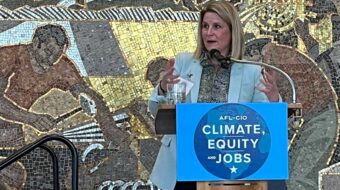
Connecticut gets almost half its energy from methane, also called natural gas. Some, especially in certain ruling circles, see this fossil fuel as a bridge to renewable energy. While methane makes up much less of the carbon in our atmosphere than carbon dioxide, it does so in an unfortunate, powerful way. Methane molecules trap 25x more radiant energy than carbon dioxide. In Connecticut, environmentalists describe this fossil fuel as a bridge to nowhere.
Energy in the state is now almost evenly divided between methane and nuclear. In the 1960-70s, energy policy experts told us that going nuclear for our energy would lead to almost zero costs for electricity. It never happened. What did happen was Three-Mile Island, Chernobyl, and more recently in Fukushima, Japan. So disasters followed the false projections.
Connecticut’s conversion from coal and oil to natural gas started bigtime in 2011 when Yale professor Daniel Esty, head of the university’s Environmental Department, was hired to take over the state’s Department of Energy and Environmental Protection (DEEP). It was Esty who pushed methane as a “bridge” to renewables. Many incentives, including free gas-line connections to homes, became available. The construction of the bridge to nowhere was off and running. Esty is now back at Yale.
Fast forward to 2021. It raised eyebrows when the public learned FedEx CEO Fred Smith donated $100 million to Yale for a center to study carbon capture to combat climate change. Smith is on the Forbes list of top U.S. billionaires. Here’s what “breaking news” didn’t say. Over the last 10 years, Smith has donated $300,000 to Mitch McConnell and other Senate Republicans. The latter has gone to extremes to block measures to mitigate climate change.
Is Fred Smith riding a horse in opposite directions?
Hardly. There is another section in ruling circles that sees carbon sequestration as a way to draw out the use of fossil fuels. It is seen as a way to keep the golden calf of fossil fuels churning out mega-profits for as long as possible. The lure is a classic offering of the technical fix. The hope is that many scientists and engineers will bite and jump on the research wagon. The message is both obvious and subliminal. It’s okay to keep knocking out those gas-guzzling trucks. High-tech gadgets will capture carbon. Enjoy the ride on fossil fuel profits, that is, and the pollution in its train.
Are there other approaches to carbon sequestration that don’t feed fossil fuel profits?
Mexico is proposing that three million trees be planted in Central America to create a million green jobs and, in the process, mitigate emigration and climate change. Those trees would remove 70 million tons of carbon from the atmosphere every year. Of course, to be effective on a planet scale, saving existing forests and other green areas has to happen along with such plantings. For example, the world’s forests absorb about 17.5 billion tons of carbon per year.
Of the three forms of carbon sequestration—technical, geological, and natural—it is the latter that heads in a healthy direction for a conscious working class, struggle approach.
Let’s use Connecticut as an example. The state has 1.7 million acres of forest. They function as carbon sinks, the old term for carbon sequestration. That may seem like a lot, except 80% of those forests are in private hands. As we’ve learned through many hard lessons, stopping unwanted development and sprawl is tough when citizens come up against private property rights.
The best direction for carbon sequestration, including a formative, collective learning experience, is to pick a place special to citizens from an aesthetic, ecological, and/or historical viewpoint. Organize a climate/passive open space committee to move your city/town to purchase and preserve such land, be it in an urban neighborhood, suburbs, or exurbs.
This grassroots pressure can lead to changes in national policy.
Given the number of millionaires and billionaires in Connecticut, a statewide wealth tax could fund a climate committee in each city or town, emphasizing a passive open space (land with no impervious, hard surfaces) approach to carbon sequestration. Greenwich alone has 11 billionaires with a combined wealth of $47.2 billion! Communities can use such a proposal to dovetail and help ameliorate other environmental problems, such as sprawl.
Another example: Letting some public forests go to old-growth status with trees topping 120 years of age. That would nurture added biodiversity with more deep forest wildlife. At the same time, it would put natural limits on deer and tick populations (think Lyme disease, as both prefer younger trees and forest edges).
Fast-tracking renewables, solar and wind in many places, is our best direction to combat climate change. Carbon sequestration via passive open space would make a solid grassroots complement to this. With organized labor, environmentalists, and racial/social justice advocates in an alliance, those struggles can yield green jobs and sustainability.
Art Perlo contributed to this article.












Comments